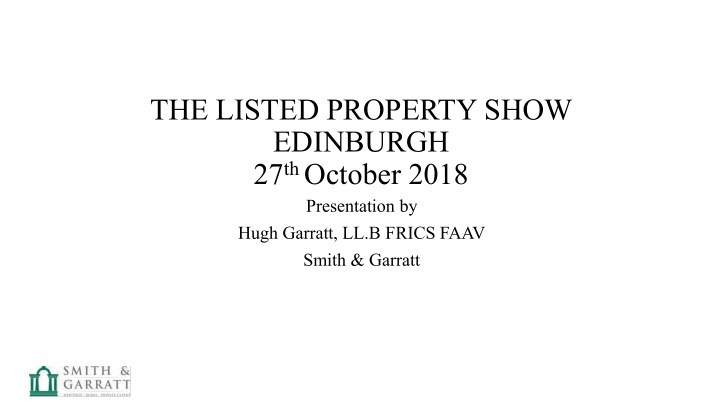



THE LISTED PROPERTY SHOW EDINBURGH 27 th October 2018 Presentation by Hugh Garratt, LL.B FRICS FAAV Smith & Garratt
“The Sharp-Eyed Purchaser”
Hugh Garratt ‘a round peg in a round hole’ • Double-qualified as a surveyor and in law • A lifetime looking after historic buildings • RICS Certified Historic Buildings Professional • Winner – Scottish Borders 2016 Special Award for Conservation & Design • Winner - Georgian Group Award 2017 ‘finest restoration of a Georgian interior’ • Winner – Historic Houses / Sotheby’s 2018 Restoration of the Year • Recently managed the restoration and delivery of Charles Rennie Mackintosh’s ‘Oak Room’ to the new V&A at Dundee
Today I’m going to run through our approach to inspecting traditional buildings with an introduction to building pathology, covering the different types of survey, what we do and what we are looking for.
Level 3 Building Survey • Levels 1 and 2 are tick-box surveys, usually part of the Scottish Single Survey or the Homebuyer Report. Pro-forma reports awarding marks out of three for each element of the building; recommend expert input for high-scoring properties. Smith & Garratt provide that expert input. • Level 3 - formerly known as a ‘structural survey’ • Thorough inspection and bespoke report • Essential to the buyer of a traditional or listed building, especially if works are required • We have surveyed about 50 listed buildings in the last 12 months
The Inspection Start outside. Find vantage points. Photograph everything. Assimilate size and orientation. Work out chronology. Spot alterations and repairs. Spot defects. Spot areas to check when inside. Move inside. Work from very top to very bottom. Confirm chronology. Spot alterations and repairs. Spot defects. Check the findings made outside. Take photos, notes and measurements to back up findings when writing the report. Sight, sound, smell, touch.
Construction & Condition • Chimneys • Ceilings • Roof Coverings • Internal Walls and Partitions • Roof Margins • Fireplaces, Flues and Chimney Breasts • Roof Void • Solid and Suspended Floors • Rainwater Goods • Stairs • External Walls and Damp Proof Course • Internal Joinery and Fitments • External Joinery and Decorations • Sanitaryware and Drains • Access • Decorations • Services • Cellar/Basement • Drains • Dampness and Condensation • Grounds and Outbuildings • Timber Decay and Infestation • General Observations • Thermal Insulation • Wiring • Plumbing • Heating
Services • Gas • Electricity • Cold Water Supply • Domestic Hot Water • Space Heating • Sanitary Fittings • Drainage • Other Facilities
The Site • Garage • Other Buildings • The Site and Local Factors • Radon Gas • Trees and Invasive Weeds • Boundaries • Wayleaves, Easements and Rights of Way • Planning and Environment Matters
The dirty dozen – 1. Water Ingress
The dirty dozen – 2. Defective Leadwork
The dirty dozen – 3. Defective Rainwater Goods
The dirty dozen – 4. Wet Rot • Usually Coniofora Puteana fungus, requires 43% moisture. Dooks, window sills and jambs, end grain. Soft. Cracks follow the grain. • There are other wet rot fungi … and there are harmless fungi.
The dirty dozen – 5. Dry Rot • Fungus Serpula Lacrymans. Origin – Victorian plant collectors. Likes food and water in cool, still pockets; hates ventilation. • Mycelium can grow at 4mm per day; 1 metre per year is normal. • Fruiting body can emit 800,000,000 spores per day! • Usually visible and detectable by smell. Breaks down cellulose, timber shrinks and cracks into cubes. • ALWAYS THINK VENTILATION
The dirty dozen – 6. Roof Defects Pay attention to: • Pitch • Head-lap • Support - sarking v battens; tilting fillet • Underlay and under-easing • Margins • Nails Scotch slate – graduated beds, one copper nail per slate, laid on sarking … should last 250 years.
The dirty dozen – 7. Wood-Boring Insects … and bats • Common Furniture Beetle makes a 1-2mm diameter round flight hole. • Death Watch Beetle makes a 2-3mm diameter round flight hole. • House Longhorn Beetle makes a 6-10mm oval flight hole. • Look for dust and dead insects. • Treat with organic solvent or paste. Treatments don’t last forever! • All bats are protected. Bat droppings crush to dust whereas mouse droppings do not. • If present, treat timbers when bats are active and specify bat-friendly materials.
The dirty dozen – 8. Cracking and Subsidence
The dirty dozen – 9. Vegetation
The dirty dozen – 10. Pointing and Renders The essential rules are: • Pointing MUST be softer (more porous) than the surrounding masonry. This rules out cement-based mortars for many types of stone and brick. • Renders should be no thicker than is necessary, should finish at a bell-cast short of the ground, should be applied in layers to keyed surfaces, and be flexible and breathable. The last two make cement-based renders unsuitable for most traditional applications.
The dirty dozen – 11. Defective Masonry • Replacement stones? • Indents? • Plastic repairs? • Silicone treatments?
The dirty dozen – 12. Rising Damp
Water rising in masonry by capillary action. Rarely above 1 metre. Absent physical barriers – DPCs and floor membranes: • Injected silicone DPCs? • Electro-osmosis? • Knapen syphons? • Aromatherapy?
OR … USE YOUR BRAIN! Minimise the water around/under the building, then 1. detach linings from damp masonry and allow to breathe; and where that’s impossible 2. devise a physical barrier.
A H Garratt LL.B FRICS FAAV The Guildhall Ladykirk Berwickshire TD15 1XL Tel: 01289 382209 / 07702 091626. E-mail: ahg@smithandgarratt.com
Recommend
More recommend